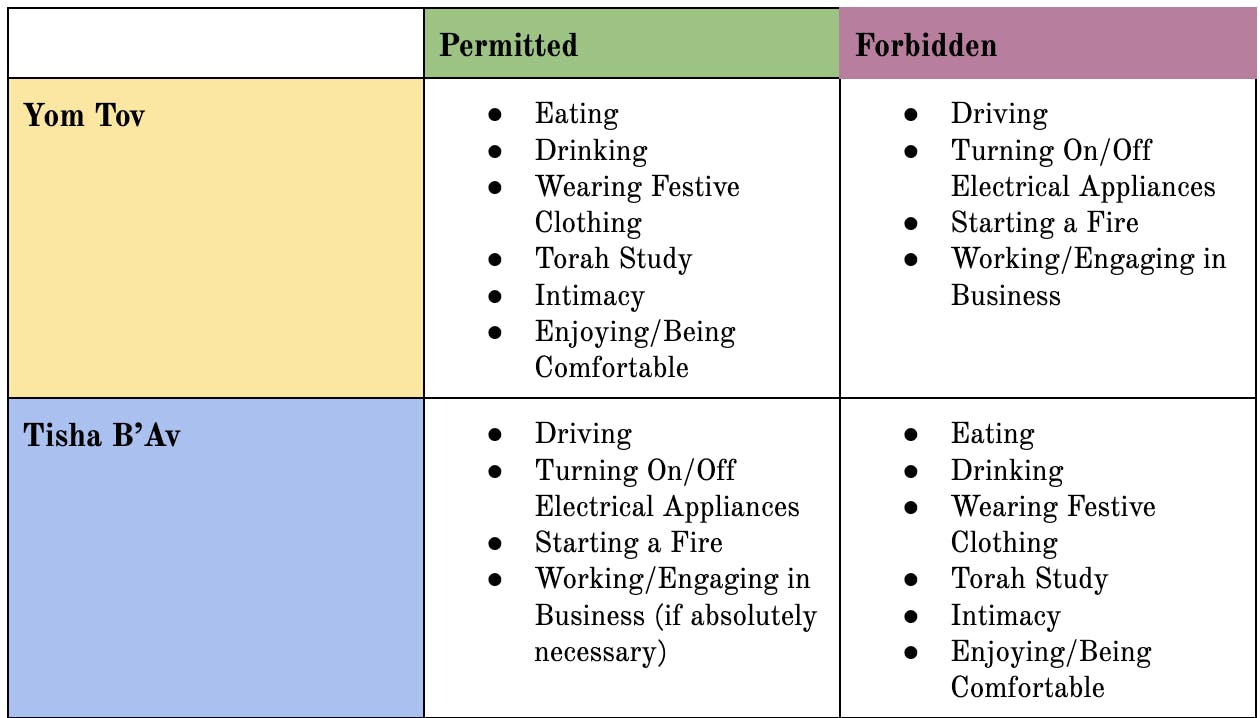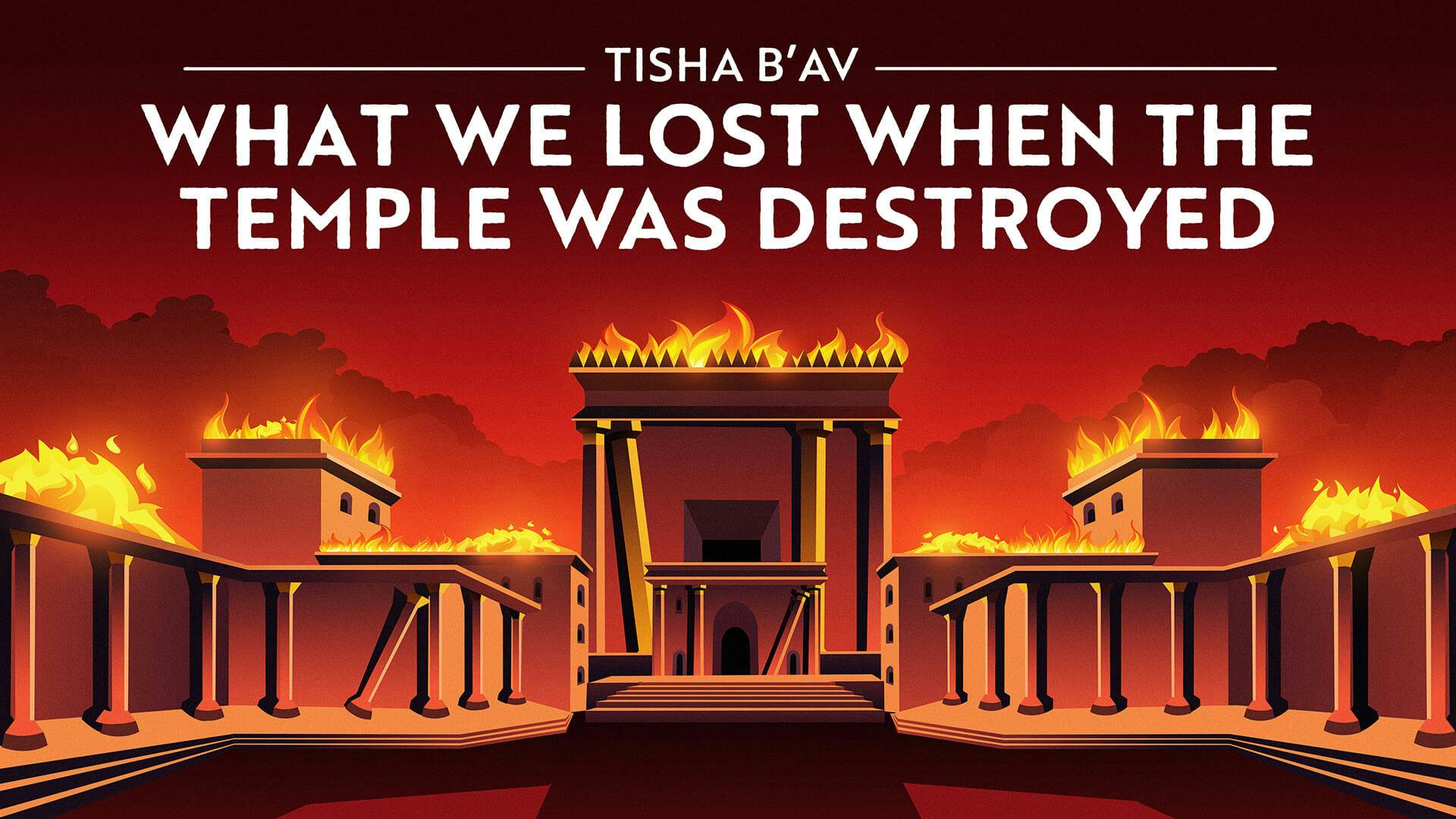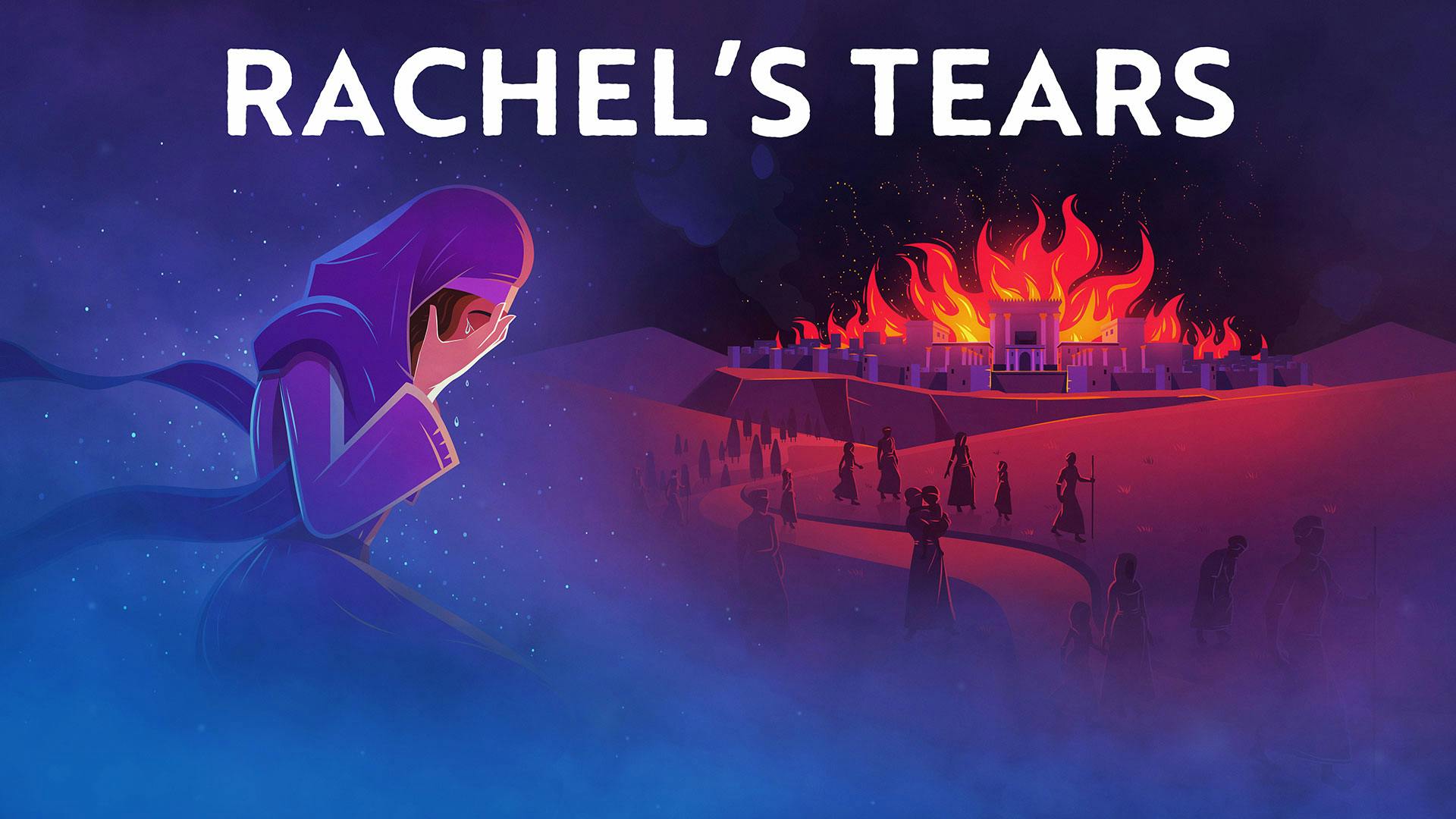Is Tisha B'Av a Yom Tov?
Understanding the Unique Nature of the Day
BY Danielle Fisher | July 18, 2024 | 5 Minute Read

How Do We Categorize Tisha B’Av?
Tisha B’Av is a unique day in the Jewish calendar. It’s a fast day, but the prayers of the day are structured differently from other fast days. For example, we don’t say tachanun, a prayer that is omitted on holidays. And even more surprisingly, the Book of Lamentations (Eicha) refers to Tisha B’av as a moed - a holiday! With its lack of festive meals, Tisha B’Av certainly doesn’t feel like a holiday. How exactly do we categorize Tisha B’Av? Is Tisha B’Av a Yom Tov?
Not Quite a Yom Tov
Only six days are referred to as “Yom Tov” in the Torah: the first and last day of Passover, Shavuot, Rosh Hashanah, the first day of Sukkot, and Shemini Atzeret/Simchat Torah. On Yom Tov, we are commanded to refrain from “weekday activities”—such as working, driving, turning on/off electronic appliances, handling money, and writing—and to engage in activities that amplify our celebration of the holiday—including eating festive meals, making Kiddush, and dressing nicely in the holiday’s honor.
By contrast, Tisha B’av is a national day of mourning. We lament the destruction of the First and Second Temples in Jerusalem and the sins that caused the devastation, and we commemorate Jewish tragedies throughout history. It’s a day when we allow ourselves to fully feel the pain of exile and yearn for the future redemption. On Tisha B’Av, we are permitted to engage in many of the activities that are forbidden on Yom Tov, including driving, using electronics, and working (in cases of great need); and we are forbidden from many of the activities that are commanded on Yom Tov, including eating, drinking, engaging in pleasurable activities/intimacy, and studying Torah!

As we can see from its restrictions and allowances, Tisha B’Av is decidedly not a Yom Tov. But then what is it?
Moed: An Appointed Time with G-d
While Tisha B’Av certainly doesn’t fit the categorization of Yom Tov, it does have a special status among the fast days. In the Book of Lamentations (Eicha), which we recite on Tisha B’Av, the prophet Jeremiah refers to Tisha B’Av as a kind of “moed,” or holiday: “The Lord has trampled all my mighty men in my midst, He summoned a ‘moed’ [lit- “appointed time”] against me to crush my young men” (1:15).
In the Torah, moadim are special days that G-d has set aside for the Jewish people to “meet” and connect with Him; many holidays, such as Passover, Shavuot, Rosh Hashanah, Yom Kippur, and Sukkot earn the Torah’s description of “moed.” The word “moed” can also refer to a place, such as the “ohel moed,” the Tabernacle where the Israelites worshiped G-d in the wilderness. The moadim signify the special relationship between G-d and the Jewish people—as if G-d were making a private date with us to spend quality-time together and strengthen our relationship.
It seems rather odd, then, that Jeremiah would refer to Tisha B’Av—the tragic day when G-d destroyed His place of meeting with us, and our relationship with G-d suffered a major rift—as a moed. What does this categorization suggest about the true meaning of Tisha B’Av and its proper observance?
Spiritual Implications
How can Tisha B’Av be both the saddest day in the Jewish calendar and a holiday? The Sages confront the same question and offer a number of possibilities:
- Spared the Worst: The destruction of Jerusalem led to mass Jewish deaths. Yet, when the Temple went up into flames, the Jews saw that G-d had finally turned His anger away from them and was taking it out instead on His holy abode. The Midrash describes the situation using a parable: it is like a father who builds his son a beautiful wedding canopy. When his son misbehaves, the father destroys the wedding canopy instead of taking out his anger on his son (Midrash Eicha Rabbah 4:14). On Tisha B’Av, we find comfort—even joy—in the mercy G-d showed when He destroyed His house instead of His people. Our gratitude for G-d’s mercy warrants a moed.
- G-d’s Unconditional Love: In the Temple, above the Aron HaKodesh [the Holy Ark], were statues of two cherubim, or angels. The Talmud says that when Israel acted according to G-d’s wishes, the cherubim would miraculously embrace; when Israel rebelled against G-d, the cherubim would face away from each other (Bava Basra 99a). The position of the cherubim was a way for the Jewish people to ascertain the status of their relationship with G-d. Incredibly, the Gemara says, during the destruction of the Temple, the cherubim were found embracing (Yoma 54B). Even at our moment of greatest distance from G-d, G-d was still close to us. On that day, we learned that G-d’s love for the Jewish people is truly unconditional. Even in exile, G-d is with us. That fact gives us hope– and the motivation to work towards a happier future.
- A Hidden Simcha: There are 22 days between the 17th of Tammuz, the fast day when we begin mourning for the Temple, and Tisha B’Av. Similarly, there are 22 days between Rosh Hashana and the end of the Yom Tov period during the month of Tishrei. If each day in the Tammuz-Av period (between the 17th of Tammuz and Tisha B’Av) is paired with a day during the Tishrei period, we see that Tisha B’Av (the final day of the Tammuz-Av period) matches up with Simchat Torah (the final day of the Tishrei period). This match-up suggests that one day, Tisha B’Av will encompass the joy of Simchat Torah!
- Future Redemption: The Sages suggest that we consider Tisha B’Av a moed on account of the future transformation of the day from one of mourning to one of redemption. They find a source for this in the prophet Zechariya’s proclamation:
- “The fast of the fourth [month], the fast of the fifth [month- Tisha B’Av], the fast of the seventh [month], and the fast of the tenth [month] shall be for the house of Yehuda for joy and for happiness and for good mo’adim” (8:19). The Sages also claim that it was during the time of afternoon prayers on Tisha B’Av, when the Temple was in flames, that the Messiah was born (Midrash Eichah Rabba 1:51). Additionally, the actual act of coming together as a people to mourn our national tragedy of losing the Temples and the tragedies of our brothers and sisters throughout history brings unity to Am Yisrael, counteracting the Sinat Chinam [baseless hatred] that caused the Temples’ destruction. So while Tisha B’Av is a time of great sorrow, it is also a time of great potential and hope, when we yearn for the future redemption and seek to bring it about through our unity.
Halachic Implications
Classifying Tisha B’Av as a moed isn’t only spiritually significant; it also has halachic ramifications. Because Tisha B’Av is a moed, we:
- Don’t recite Tachanun [prayers of confession/supplication] during mincha [afternoon prayers] before Tisha B’Av or on the day of Tisha B’Av itself. Typically, we say Tachanun every day except on Shabbat, holidays, and special joyous occasions.
- Add the prayer Nachem during mincha to ask G-d to console us.
- Some Sages claimed that we should not say Aneinu [a prayer which is typically recited on fast days] on Tisha B’Av during the Shemonah Esrei [the Amidah].
We not only hope for the day when Tisha B’Av will turn from a “moed” of mourning to a “moed” of joy; we anticipate it through structuring the day like a holiday.
Looking for more?
We have hours of delightful videos and podcasts to enhance your Purim celebration this year.
Final Takeaways
Tisha B’Av is a day filled with paradoxes. It’s certainly not a Yom Tov, but it’s also not a typical fast day; it’s called a moed, but it’s qualitatively different from the other moadim listed in the Torah; it’s a day of mourning, but also one of hope. Tisha B’Av’s status as a “moed yet to be realized” reveals to us the immense potential latent in the day– the potential for the day of our greatest tragedy to transform into our greatest redemption. May we soon merit to see Tisha B’Av transform from a day of sadness to one of hope, from a moed of tragedy to a moed of the greatest simcha we can imagine.
Sources:
- https://torahmitzion.org/learn/tisha-bav-a-moed/#:~:text=How%20can%20such%20a%20tragic,will%20become%20days%20of%20joys
- https://www.chabad.org/library/article_cdo/aid/4817724/jewish/Why-Is-Tisha-BAv-Afternoon-Less-Mournful.htm
- https://www.torahweb.org/torah/2021/moadim/rros_9av.html
- https://torah.org/torah-portion/nesivosshalom-holiday/
Top Tisha B'Av Videos

How Am I Supposed To Appreciate The Loss Of The Beit HaMikdash?
Video series • Part 1 of 7 • 9 min
It’s one thing to mourn the suffering of actual people, but how are we supposed to feel genuinely sad over the loss of a building?

Reversing Tisha B’Av: How To Actually Rid Ourselves Of Sinat Chinam
Video series • Part 1 of 5 • 8 min
We sit on the floor, we cry – but sometimes it feels like we’re just going through the motions. Rachel Imenu shows us a deeper way to mourn — that actually changes us, that banishes sinat chinam, baseless hatred, from our hearts.

Tisha Bav Sinat Chinam Guide for Kids
Video series • Part 1 of 5 • 2 min
Part 1 of Tisha b'Av Sinat Chinam Guide for Kids. See the full guide here. For more on how to spend Tisha b'Av with kids see here.

Why Does God Let Us Suffer?
Video series • Part 1 of 6 • 11 min
If God loves us, why does God let bad things happen to us? This question may be impossible to answer, but on Tisha b’Av it’s just as impossible to ignore.
More Tisha B'Av Content
What is Aleph Beta?
Aleph Beta is a unique kind of Torah library. Led by our founder, Rabbi David Fohrman, we are dedicated to high-level, textual Torah learning for adults that is intellectually and spiritually sophisticated, that enlivens your Jewish practice and helps you forge a deeper connection to God. Whether you’ve been learning in yeshiva for years or you’re just beginning your Torah journey, you’re sure to find something meaningful and surprising waiting for you here.
Browse our library of over 1,000 beautifully produced animated videos, podcasts, deep dive courses, and printable guides. Topics include the weekly parsha, Jewish holidays & fast days, laws & mitzvot, prayers, relationships, big philosophical ideas and more. Have something to say at the Shabbos table that will amaze your family and guests and bring deep meaning into their lives.




